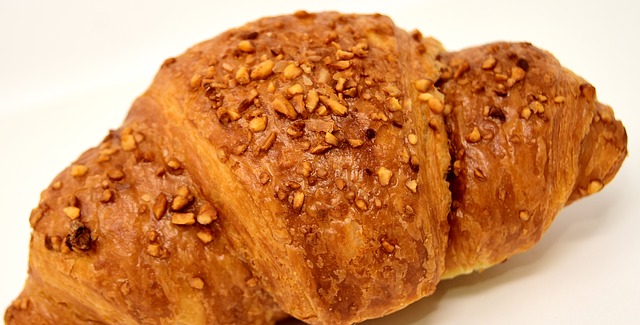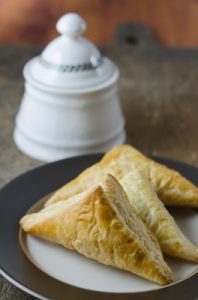
Puff pastry is one of life’s pleasures and it is tricky to make but worth the effort. Most people buy it ready prepared if you haven’t the time.

What is Puff Pastry?
The pastry itself is simply a laminated flaky product with a very open structure and is often combined with cream and fruit to make a variety of baked confectionary products. It has been with us since the 1400s having been developed in France. The richness is due to large amounts of butter which provides the fat.
The pastry is prepared by interleaving very thin layers of dough separated by fine laminations of fat. During baking, the dough layers expand as moisture evaporates to steam. The melting fat insulates the dough layers causing them to cook individually which provides the lift and separation and the flakiness of the pastry. The gluten coagulates to form a light, open structure of many fine layers. There is no leavening involved nor is sugar added.
The manufacture of puff pastry is covered in a variety of technology books (France, 1969) or for a more modern take try “Advanced Bread and Pastry” by Michel Suess.
Using Ready Made Puff Pastry
To be perfectly honest, puff pastry and filo pastry for that matter are almost as good as the homemade pastry. A number of chefs now rely on ready made because it is so well produced and versatile. It is best kept in the fridge. Just make sure to take it out in plenty of time to defrost at room temperature. As in making the puff pastry, when you are rolling out the ready-made, just keep an even pressure on it so that any pies or pastries using it rise evenly. Sprinkle all work surfaces only lightly with flour because you don’t want the pastry to become dry but it mustn’t stick to the work surface. Filo pastry which is made by a similar process but of even thinner sheets dries terribly. Chefs use plastic wrap and even a teacloth to keep everything as moist as possible. Always use as quickly as possible once thawed.
A range of manufacturers provide a ready supply of puff pastry. The US brand, Pepperidge Farm have a great web-site for recipes and features using the dough whilst we in the UK can rely on Jus-Rol (trademarked) and a number of own-label suppliers like Waitrose. Likewise, Paul Hollywood shows you how to make it.
If you are interested in other variants, why not try cheese puff pastry. That recipe uses ready made but it can easily be adapted using the method of preparation described here.
How to Make Puff Pastry
The method of preparation is such that puff pastry should be made in as large an amount as feasible because so much effort goes into its make up.
Equipment (Baking):
Ingredients:
- 150g (just under 2 cups) plain flour or all-purpose flour with extra for dusting and rolling out on.
- 100g (1 cup plus 1-2 Tbsp) strong white flour
- 250g salted butter, cubed/diced and chilled in the fridge or the same amount of unsalted butter but add a pinch of salt
- 100-120ml (7-8 Tbsp) ice-cold water
- 1 medium egg yolk
- 1 tsp lemon juice (a good idea)
Preparation:
- Cube or dice 50g of chilled butter (3½ Tbsp).
- Mix the flour in a large mixing bowl then add butter and rub using the fingers until the butter is well incorporated into the flour and it is slightly flaky.
- Make a well in the butter-flour mix. Add the egg yolk, 6 Tbsp of iced water, lemon juice and mix with a plastic spatula or round-bladed knife.
- Add water to keep the dough going but do not add too much otherwise it becomes too sticky.
- Make a dough ball and flatten into a neat rectangle.
- Cover with plastic wrap or cling film and chill for an hour at least.
- Dust a cool work surface with enough flour.
- Roll out the dough into a flat rectangle which is about 3-4 times longer than it is wide. The short side should be closest to you.
- Any butter left over is then placed between 2 sheets of baking parchment.
- With a rolling pan, flatten the butter into a neat square which is also smaller than one-third of the pastry rectangle.
- Fold the bottom third over it, brush off the excess flour and fold the top third down so the butter is completely encased.
- Then turn the square clockwise by 90 degrees. Redust the surface and rolling pin with flour.
- Roll out the pastry into a neat rectangle of a similar size to before.
- Paul Hollywood uses short, tapping and rolling actions not long sweeping rolls. he uses his hands to keep the pastry neat and tidy as it is rolled out.
- As before with the folding of the dough, the bottom third of the rectangle is folded over the middle third and the top third down. Always brushing off any excess flour.
- The square is turned 90 degrees clockwise, the dough is wrapped in plastic wrap and the square kept flat and in the same rotation. The dough flat is chilled for 1 hour.
- The work surface is dusted again with dough rolled out into a similar triangle. All ends and sides are kept as neat as possible.
- The dough is then folded as before. Turned 90 degrees clockwise and the whole folding repeated. It is covered in plastic wrap with the square in the same position and chilled again for another hour.
- The rolling and folding is repeated twice more with the dough being rolled out and turned 90º between each folding action. Keep chilling and rolling. It should have 6 goes.
- Leave the pastry folded and covered in clingfilm and chilled for another 2 hours and then it is used.
- Any excess puff pastry can be frozen and it keeps extremely well over 6 months.
Puff Pastry Products
Please note this page contains links to our affiliate marketing partner. we are an Amazon and Alibaba Associate. Please read our affiliate disclosure.
Reference
France, W.J. (1969) The Students Technology of Breadmaking and Flour Confectionary. Third ed., Ch. 22. Routledge & Kegan Paul Ltd. London
Suess, M. (2008) Advanced Bread and pastry: A Professional Approach. 1st edt. Delmar Cengage Learning. USA
Leave a Reply